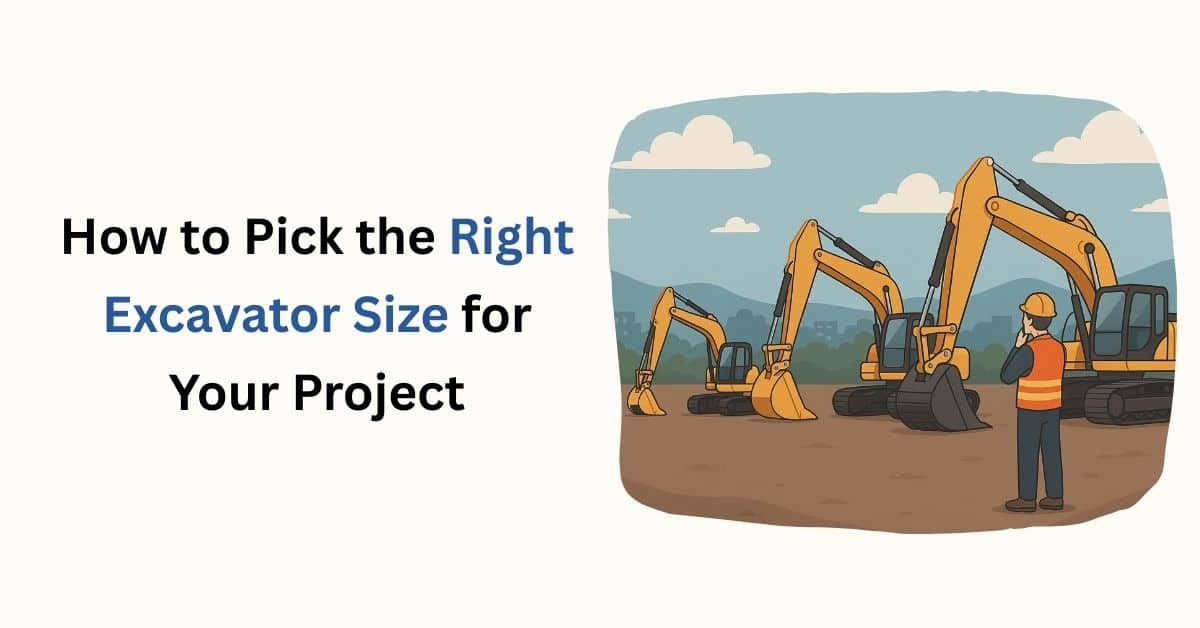

How to Choose the Correct Excavator Size for Your Project
That sinking feeling hits hard when you’re watching thousands of pounds disappear because your excavator can’t handle the job. Last month, a site manager in Birmingham watched his crew stand idle for three hours while waiting for a machine swap, turning a profitable morning into a costly disaster. The excavator looked powerful enough in the rental yard, but reality struck when it couldn’t reach the required depth. These equipment nightmares happen daily across construction sites, costing contractors their reputation and profit margins. Therefore, choosing the correct excavator sizes prevents these mistakes and keeps projects running smoothly.
So, here is the guide that discusses the way to pick the right excavator sizes.
Understanding different excavator categories
The construction industry offers three main excavator categories, each specialising in specific project needs.
Mini excavators
The mini excavators of 1-6 tons are useful in narrow areas and domestic work where accessibility is minimal. These small machines are used to do the landscaping work, utility repairs, and indoor demolition without disturbing neighbouring structures. For smaller projects, hiring a man with a digger offers an efficient, all-in-one solution.
Mid-size excavators
These excavators are between 7-15 tons and are versatile in general building construction, foundation work, as well as in moderate ground-moving projects. They balance power and mobility for most commercial applications.
Large excavators
The heavy excavators of 16-40 tons address heavy road construction, large excavation and industrial demolition.
You will get to know these in detail in an excavator size chart that displays operating weights, dig depths, and reaching capabilities.
Key factors that determine your equipment needs
Start with a thorough evaluation of work requirements and site-specific challenges.
Residential works need compact machines that protect driveways and landscaping from damage. At the same time, commercial construction requires powerful equipment capable of moving large material volumes easily. Site accessibility limits equipment options immediately, whereas narrow gates, overhead obstacles and weight restrictions rule out specific digger size choices. And conditions of the ground affect stability and performance.
Consider the following project specifications:
- Total excavation volume and timeline
- Maximum dig depth requirements
- Material handling needs and bucket capacity
- Transportation logistics and site access points
- Adjacent structure proximity and sensitivity
- Cost/budget factors, such as rental duration
Using an excavator size chart effectively
Professional contractors use detailed specifications to match equipment capabilities with project needs.
The digger size chart is used to compare the depth of the dig, reach, lifting capacity, and transport size of various models. The operating weight is directly proportional to the power output, fuel consumption, and transportation necessary in budget planning.
Dig depth requirements should be larger than your maximum excavation requirements, including safety factors. At the same time, reach measurements indicate the working distance between the machine position, which influences productivity and how many times it needs to be repositioned. Lifting capacity charts show the maximum loads at different distances, which are very important when handling materials.
Hence, align those specifications and select the right digger size.
Cost consideration and productivity analysis
The expense of equipment changes depending on the size of the excavator; hence, financial analysis is important for profitability.
Smaller machines are cheaper to operate on a daily basis, but can also prolong the project schedule with lower work rates. Big machines are rented at high rates and also work more quickly and do not need a lot of positioning. The larger the machine size, the higher the fuel consumption and the operation costs during rental periods. The cost of transportation also increases when carrying bigger equipment that needs special trailers and permits. Consider muck away London services to manage waste removal efficiently alongside your excavation operations. When equipment size is correct, labour efficiency also increases, since operators do not require much effort to complete work.
Hence, calculate the total project costs as a sum of rental, fuel, transportation and work hours instead of concentrating only on daily rates.
Conclusion
Analyse your project requirements, site conditions, and budget constraints together, and that’s how you can pick the right size for your project. These digger size principles outlined help contractors to make informed equipment decisions that maximise productivity while controlling costs. So, take time to assess your specific needs before making rental decisions. For quick, expert guidance on equipment selection and professional grab services, get in touch with GW Grab Services, which holds the expertise and reliability your projects need.

